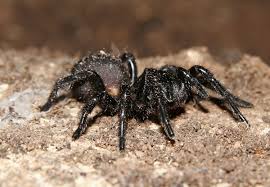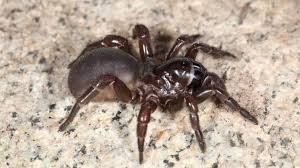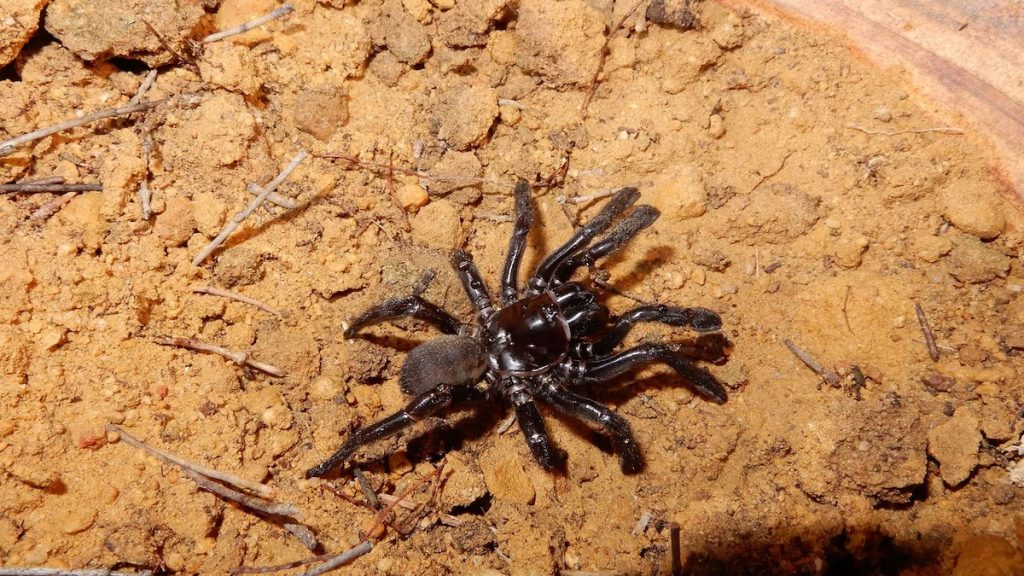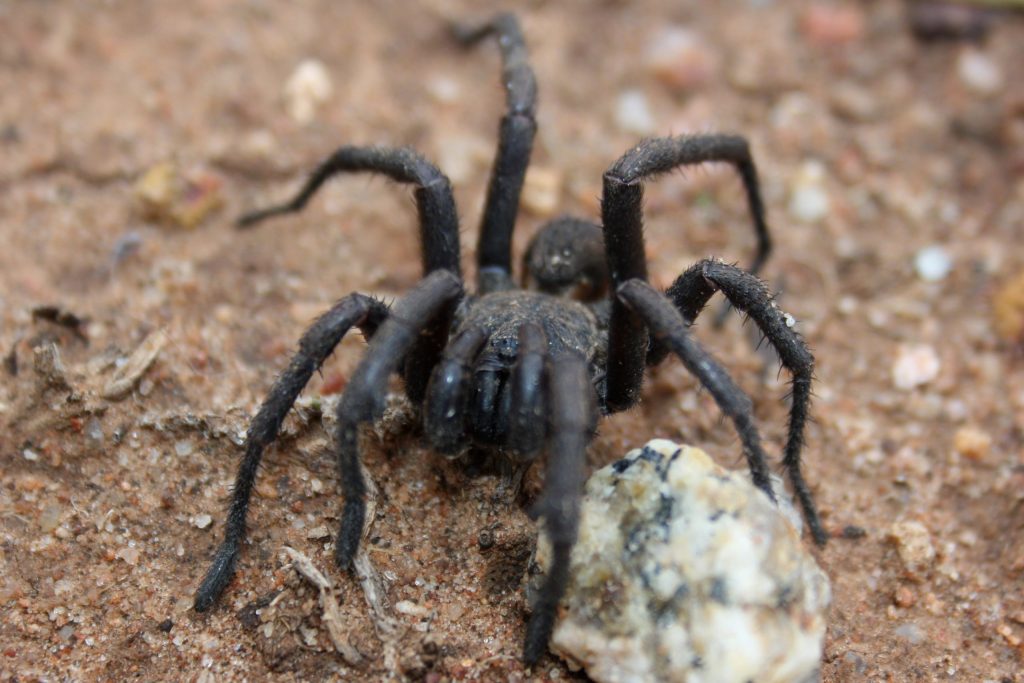
Trapdoor Spiders – Idiopidae
This family contains a variety of burrowing spiders live beneath the ground in silk-lined burrows. Some species build silk-hinged lids (trapdoors) on their burrows, while other have open lidless entrances. Most of these spiders are stocky in build and are dark earthy colours and as a result of often confused with funnel-web spiders, although they are generally lighter in colour than the glossy black funnel-webs, or have more hair on the cepahlothorax than their more venomous cousins. While the spiders in this group have large fangs they are not regarded as dangerous.
Trapdoor Spiders – the full story
A common resident of the garden, trapdoor spiders are found across eastern and southern Australia, including Tasmania. They are often encountered whilst moving rocks or digging soil. They are brown or black and can be up to 3.5 cm long. Some males look like they have large boxing gloves near their mouth. These are called palps and used for mating.
At night, shining a torch across the lawn may pick up two rows of tiny shining eyes staring up from inside a hole. These burrows can be as long as 40 cm and are lined with soft silky web.
There are many different species of trapdoor spider. Some don’t actually make a hinged door, but all have one thing in common: they dig a burrow in which to lurk awaiting their next victim.
With the door open just a crack, they wait for an unsuspecting cricket or beetle to wander past. The spider leaps out at great speed, seizes its prey and hauls it back into the burrow to be devoured, all in a fraction of a second.
Trapdoors live between 5 to 20 years, and take several years to reach maturity. The female trapdoor can grow up to 3 cm long and live for as long as 20 years. She spends her entire life inside the burrow. Males have a much shorter life. After 2 or 3 years they leave the burrow in late autumn or early winter to roam around in search of a mate.
Trapdoors are shy and usually flee from any threat (although males may rear up if startled). Trapdoors have large fangs which may cause a painful bite with some pain and swelling. However, their bite is not dangerous. But it’s a good idea to always give spiders a bit of space if you can.


What do trapdoor spiders look like?
There are many different species of trapdoor spider. They are brown or black and can be up to 3.5 cm long. Some males look like they have large boxing gloves near their mouth.
Trapdoor spiders look quite similar to the far more dangerous Funnel-web Spider. Both are large, dark and rather stubby with a hairy coat. If in any doubt, exercise extreme caution.

Where are trapdoor spiders found?
A common resident of the garden, trapdoor spiders are found across eastern and southern Australia, including Tasmania. They are often encountered whilst moving rocks or digging soil. Some don’t actually make a hinged door, but all have one thing in common: they dig a burrow.
trapdoor spiders Fast facts:
Trapdoors play an important role in controlling numbers of beetles, cockroaches, crickets, slaters and other spiders.
Trapdoors are shy and usually flee from any threat (although males may rear up if startled). Trapdoors have large fangs which may cause a painful bite with some pain and swelling. However, their bite is not dangerous. But it’s a good idea to always give spiders a bit of space if you can.
The Fascinating World of Trapdoor Spiders

Photo by JamesDeMers on Pixabay
Possessing a unique lifestyle, trapdoor spiders have captivated the interest of many. As remarkable architects of the animal kingdom, these spiders construct burrows with a hidden trapdoor made of silk, vegetation, and soil. This article unravels some of the most astonishing and interesting facts about trapdoor spiders, delving into their characteristics, habitat, diet, and more.
Overview of Trapdoor Spiders
Trapdoor spiders belong to a medium-sized infraorder of spiders known as Mygalomorphae. They are commonly found in warmer climates across the globe, with a strong presence in regions like Japan, Africa, South America, and North America.
These spiders stand out due to their unique burrow construction skills. They create burrows with a hidden trapdoor that serves as an effective deterrent against enemies and a strategic point for attacking prey.
Key Facts about Trapdoor Spiders
Here are some noteworthy facts about these intriguing creatures:
- Trapdoor spiders construct trapdoors with different appearances, varying from wafers to corks, which operate through a fold or hinge.
- Females rarely leave their burrows, while males go out in search of a mate.
- Most species are harmless to humans, though some like the mouse spider can deliver a painful bite leading to medical complications.
- Their burrows can measure up to 12 inches long and are often located near other burrows.
- Apart from insects and other arthropods, their diet may occasionally include small frogs, birds, snakes, mice, and fish.
Identifying Trapdoor Spiders
Trapdoor spiders are typically dark in color, ranging from yellowish brown to black. They are stocky spiders with short, thick legs and a lightly hairy body. Adult spiders can reach an average length of 2.5 centimeters, and some can even measure up to 4 centimeters.
They possess powerful jaws and sharp fangs that they use to stab their prey. They have eight eyes, with a pair in the middle and three on each side. Their bodies are thinly covered with hairs, and they can run very fast.
Habitat and Burrows
Trapdoor spiders are predominantly underground dwellers. The burrows they construct serve as their homes, hunting grounds, and protective shelters. These burrows can be about 30 centimeters deep and 5 centimeters across. Some trapdoor spiders prefer to construct their burrows beside creeks or rivers, enabling them to catch small fish.
The trapdoor that these spiders construct is difficult to spot when it’s closed, thanks to the effective camouflage of plant and soil materials. The trapdoor is hinged on one side with silk, and the spiders, who are mostly nocturnal, typically wait for their prey while holding onto the underside of the door.
Diet and Hunting Techniques
Trapdoor spiders have a carnivorous diet, consuming a wide variety of insects and other arthropods. They are known to eat frogs, baby birds, baby snakes, mice, and small fish.
Being ambush predators, trapdoor spiders employ a unique hunting technique. They wait for their prey behind their half-open trapdoor, sensing their approach through vibrations. Once the prey comes close enough, the spider swiftly jumps out of its burrow and captures it.
Reproduction and Lifespan
The mating ritual of trapdoor spiders is quite fascinating. Mature males wander during humid weather in search of a mate. The mating takes place within the female’s burrow, and remarkably, the male usually manages to escape being eaten, enabling him to mate with several females before dying.
Female trapdoor spiders lay their eggs several months after mating and protect them within their burrow. When the spiderlings hatch, they stay with their mother for several months before venturing out and constructing their own miniature burrows.
Trapdoor spiders have a long lifespan, ranging between 5 to 20 years. They take several years to reach maturity, with females staying in or near their burrows, while males leave their burrows once mature and go in search of a mate.
Venom of Trapdoor Spiders
Although trapdoor spiders are non-aggressive and usually timid, they can stand up and present their fangs if harassed. The bite of a trapdoor spider is of low risk to humans, and they rarely bite. However, if they do, it can be very painful. Local pain and swelling may occur, especially in the case of brown trapdoor spiders and sigillate trapdoor spiders.
Threats and Predators
Trapdoor spiders face threats from various predators, including wasps, scorpions, and humans. If a wasp finds the burrow, it will quickly run into the spider’s burrow and sting the spider. Other predators that pose a threat to trapdoor spiders include birds, bandicoots, centipedes, and parasitic wasps and flies.
Trapdoor spiders are truly captivating creatures. Their unique lifestyle, architectural skills, and hunting techniques make them one of the most interesting species of spiders. Despite their fearsome appearance, they generally pose little threat to humans and play a crucial role in the ecosystem by controlling the population of insects and other arthropods.
